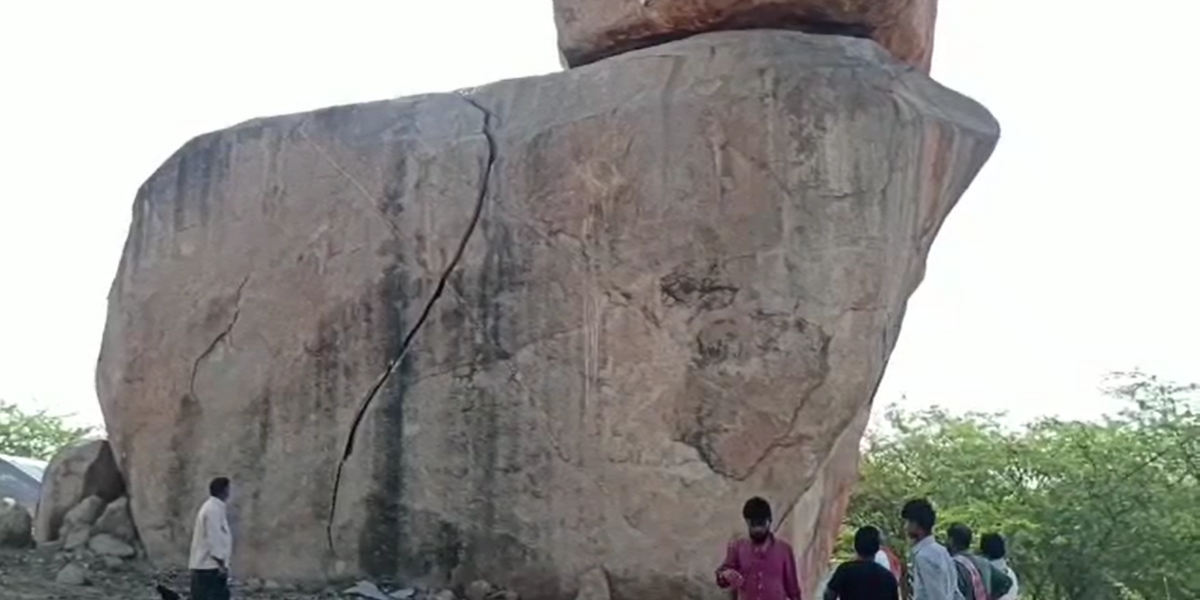(Disclaimer: The headline, subheads, and intro of this report along with the photos may have been reworked by South First. The rest of the content is from a syndicated feed, and has been edited for style.)
The Kurnool district administration has roped in nearby cement companies and renewable energy company Greenko to help stabilise the rock.

The rock that is estimated to be 500 years old is on the outskirts of Gonegandla village in Kurnool. (Screengrab/Twitter)
The sweltering summer heat has split open a large rock located at an elevation amidst houses in Gonegandla village of Kurnool district of Andhra Pradesh.
Kurnool district Collector Srijana Gummalla on Wednesday, 12 April, said that the incident occurred in the Adoni sub-division on Tuesday, leading to the evacuation of 150 families from the rock’s vicinity to avert any untoward incidents.
“There is a crack in the rock but, thankfully, the crack has not expanded since Tuesday. There was the fear of it disintegrating and going down. We have deployed State Disaster Response Force (SDRF) teams at the site,” said Gummalla.
She said that the district administration has also roped in nearby cement companies and renewable energy company Greenko to help reinforce and stabilise the broken rock.
For the safety of the evacuees, Gummalla said that they have been accommodated in a nearby school for now as fragments of the rock may crash onto their houses if the situation aggravates. The school is located against the slope behind the rock’s location.
Considering that no quarrying occurred at the site of the incident, the collector observed that the scorching summer heat could be the reason for the split, even as no other suspicious activity was found to have occurred at the rock site.
However, an official from the Meteorological Department said that Kurnool district did not record abnormally high temperatures on Tuesday, while the Andhra Pradesh State Disaster Management Authority (APSDMA) recorded Gonegandla’s maximum temperature as 38.2 degrees Celsius on the same day.
In the meanwhile, the sub-collector, tehsildar and police teams are monitoring the situation in the village.
Incidentally, the Geological Survey of India (GSI) did not receive information on this development until Wednesday morning, said Janardhan Prasad, its additional director general (ADG).
“We have not received any complaints or report from the local government officials. If the Department of Mines and Geology, Government of Andhra Pradesh, writes to us, I will certainly send one team to see that area,” said Prasad, who oversees southern India for GSI.
Later, on being alerted by reporters, Prasad said that GSI has discussed with the district administration and was informed that the situation is under control.
He said that a GSI team may go to Gonegandla if required, but no team has been dispatched as of now. However, Prasad clarified that unless a geologist personally examines the crack, he cannot come to the conclusion if the crack is an old one or a recent one.
For Wednesday, the disaster management authority forecast a severe heat wave in the four mandalams of Kunavaram (46 C, Alluri Sitharamaraju district), Golugonda (42.6 C, Anakapalle district), Nathavaram (42 C, Anakapalle district), and Kotananduru (41 C, Kakinada district).
Likewise, heat waves are predicted in 126 more mandalams across the state, all of them estimated to log temperatures over 40 C.
In December 2022, a World Bank report titled ‘Climate Investment Opportunities in India’s Cooling Sector’ said that the country is experiencing higher temperatures that arrive earlier and stay far longer.
Predicting that the heat wave situation in India could break the human survivability limit, it said that the recent heat wave supports what many climate scientists have long cautioned us about with reference to rising temperatures across South Asia.
(Disclaimer: The headline, subheads, and intro of this report along with the photos may have been reworked by South First. The rest of the content is from a syndicated feed, and has been edited for style.)

Apr 18, 2024

Apr 18, 2024

Apr 17, 2024

Apr 17, 2024

Apr 17, 2024